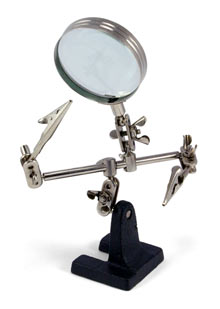Building a more useful Third Hand |

Many times some type of small holding device is needed when doing electronics or other hobbies. This type of device is commonly referred to as a third hand. Many third hand type holding devices are commercially available but I found them lacking in a few aspects. Typically a commercial third hand is a bit like this one.

I find this type of third hand a bit lacking for my projects. The first problem I have is that the arms are very short and only bend in a few places limiting you to smaller objects and placement of the alligator clips. The next thing is the base. The base is very light limiting it to the size of the object it can hold. The base also does not sit directly under the part being held creating an unstable mount. The magnifying glass has always been of little use to me and mine was removed years ago.

Third Hand by Instructables.com user rstraugh
Inspired by the project found here, http://www.instructables.com/id/Third-Hand-A-multi-use-helping-hand-for-electro, I set out to create a more useful third hand.
In the project above a system of flexible tubing called Loc-Line was used. Loc-line is typically used on milling machines or drill presses to provide precise placement of dust removal air flow or cooling fluids. The nice thing about Loc-Line is that it is very flexible allowing placement of the alligator clips in many more places than the commercial units offer. Loc-Line is also a bit tough to move allowing you to hold heavier objects. Loc-Line is also very modular. It can be extended and shortened as needed so it's up to you to decide how long the arms will be.
For my project I choose ½" Loc-Line. In the guide above ¼" line was used. I felt that the ½" would be easier to work with and would allow for heavier objects. More importantly, I had it on hand. I also choose to use only two hands instead of three. Again, this is up to you to decide how many arms you need.

One of my goals was to create a heavy solid base that would not tip over easily. For my base I used steel angle iron welded together in a triangle pattern with the Loc-Line is attached in the back. This gave me a nice solid base that would not tip over easily. If you would rather not use a welder or don't have access to one you can just as easily use bolts. Anything can be used as a base; a block of wood could also be used. The Loc-Line arms were attached to the base with epoxy.

Alligator clips were used for the hands. Supplied with the Loc-Line kits are different sized nozzles. A small round nozzle fit almost perfectly with the alligator clips end. The clips were then inserted into the nozzle and epoxy was poured in the end. To prevent the epoxy from running out a few drops of hot glue were put around the end of the nozzle and left to dry and then removed once the epoxy had dried.


Once all the glue dried the base was painted black. This part is not necessary but I think it made it look better.


